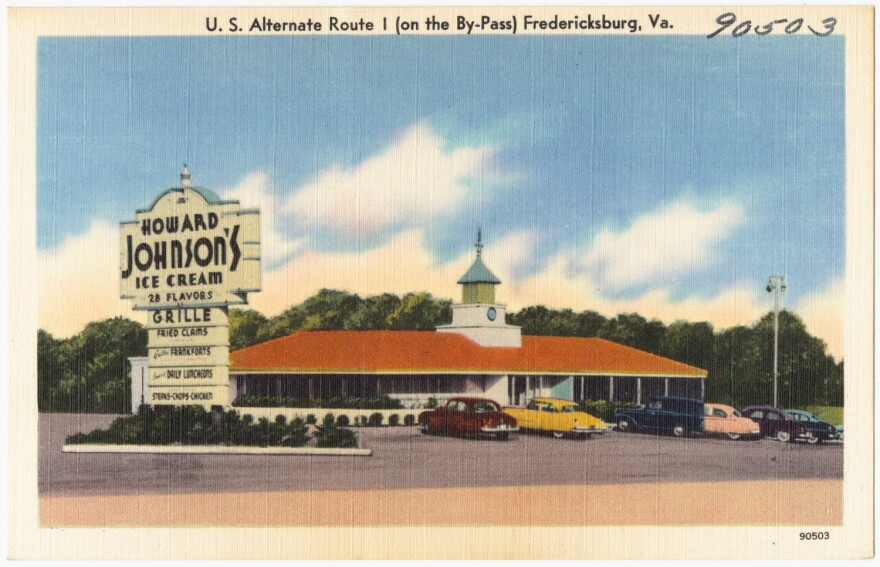When's the last time you ordered turtle when you went out to eat?
Most of us would probably turn it down in an instant if we saw it on a menu. But terrapin was a completely normal entree for diners at the finest restaurants of a century ago. America's changing tastes — and what they have to say about our culture — are explored in a new nonfiction book, Ten Restaurants That Changed America.
It begins with Delmonico's, a grand Gotham destination since 1837, with clubby red leather chairs, black and white tile floors and mahogany panels.
"You can't have the modern American restaurant without Delmonico's," explains author Paul Freedman. A professor of medieval history at Yale University, Freedman studied the spice trade before training his scholarly sights on the social history of the U.S., as told through eating out.

Delmonico's was not the first restaurant in America, but it raised the bar, Freedman says, for all the hash houses, oyster cellars and taverns that were then the only places in the country to sit down and eat. "Delmonico's is the first to have refined offerings, beautiful food, beautiful surroundings, well-mannered waiters — a bit of Paris in New York," he rhapsodizes.
Abraham Lincoln loved Delmonico's potatoes. Mark Twain threw his 70th-birthday party there. And after Oscar Wilde ordered the turtle — or terrapin, rather — he raved about it in an 1885 essay, pronouncing: "The two most remarkable bits of scenery in the States are undoubtedly Delmonico's and the Yosemite Valley."

Freedman used the following criteria in picking his 10 restaurants: They had to be exemplary, and thus, widely copied. Or they came to define a category. His list includes Schrafft's, a Northeast chain of restaurants, launched around the turn of the 20th century, that catered to female clients at a time when a woman dining sans a male companion faced social stigma or worse; Antoine's of New Orleans, which started in 1840 and embodied upscale regional cooking in its day; the famously snooty Manhattan restaurant Le Pavilion, for its redefinition of fine French cuisine; and Chez Panisse in Berkeley, Calif., which helped launch the local, seasonal ethos that now dominates in so many kitchens today.
He chose Mama Leone's, of New York, for defining a category. It closed in 1994 but when it started almost a century earlier, Mama Leone's was a haunt for Italian immigrants and artists, including opera star Enrico Caruso. Over the years, Freedman says, Mama Leone's became a veritable Vesuvius of red-sauce joint cliches: "Flirtatious waiters, lots of entertainment, naked statues, huge portions."
Mama Leone's was one of the first theme restaurants — meaning, with a shtick beyond its food. Freedman's chapter about it is also a mini-history of Italian eateries in America. He uses restaurants to examine class mobility, the civil rights movement, and women's changing status. Jane Kramer wrote about Ten Restaurants That Changed America in this week's New Yorker magazine. She remembers eating at Sylvia's, the famous soul food restaurant in Harlem in the 1960s, and power lunching at the Four Seasons in the 1980s.
"He captured the zeitgeist perfectly," she says. Kramer says she adored Ten Restaurants That Changed America in part because it's thoughtful about the conflict between an elite food culture with beautiful dining-out options and fast-food restaurants churning out fare high in fat and sodium for the majority of Americans.
Kramer says still, she would have appreciated more regional and ethnic diversity. Nearly all of the places in Freedman's book are — or were — based in Manhattan. She was impressed by a chapter about San Francisco's Mandarin restaurant — which takes an opportunity to delve into the history of Chinese food in America and Chinese immigration to the U.S. — and a look at one national chain, Howard Johnson's, which redefined how a broad swath of middle-class families dined on the road.

About half of the influential restaurants Paul Freedman picked are now out of business. Delmonico's almost closed several times. Prohibition nearly killed it. "It declined precipitously by the first world war," Freedman says. "It had horrible things, like turkey hash with fried banana." (Many vintage menus from the restaurants are included in the book. They're fascinating relics.)
Back in its Gilded Age heyday, Delmonico's was the birthplace of Lobster Newberg and Baked Alaska. Executive chef William Olivia told NPR he constantly refers to The Epicurean, a cookbook created by Charles Ranhofer, an early Delmonico's chef. It was written in 1894 and contains almost 4,000 recipes. "I look at it all the time," he says. "I'll actually take ... The Epicurean out and say, 'Is there anything we can make work today?' "
The answer, more often than not, is no. Delmonico's currently caters to a Wall Street clientele with a taste for steak and cocktails. Olivia does not anticipate a return to turtle on the menu anytime soon.
Copyright 2023 NPR. To see more, visit https://www.npr.org.




